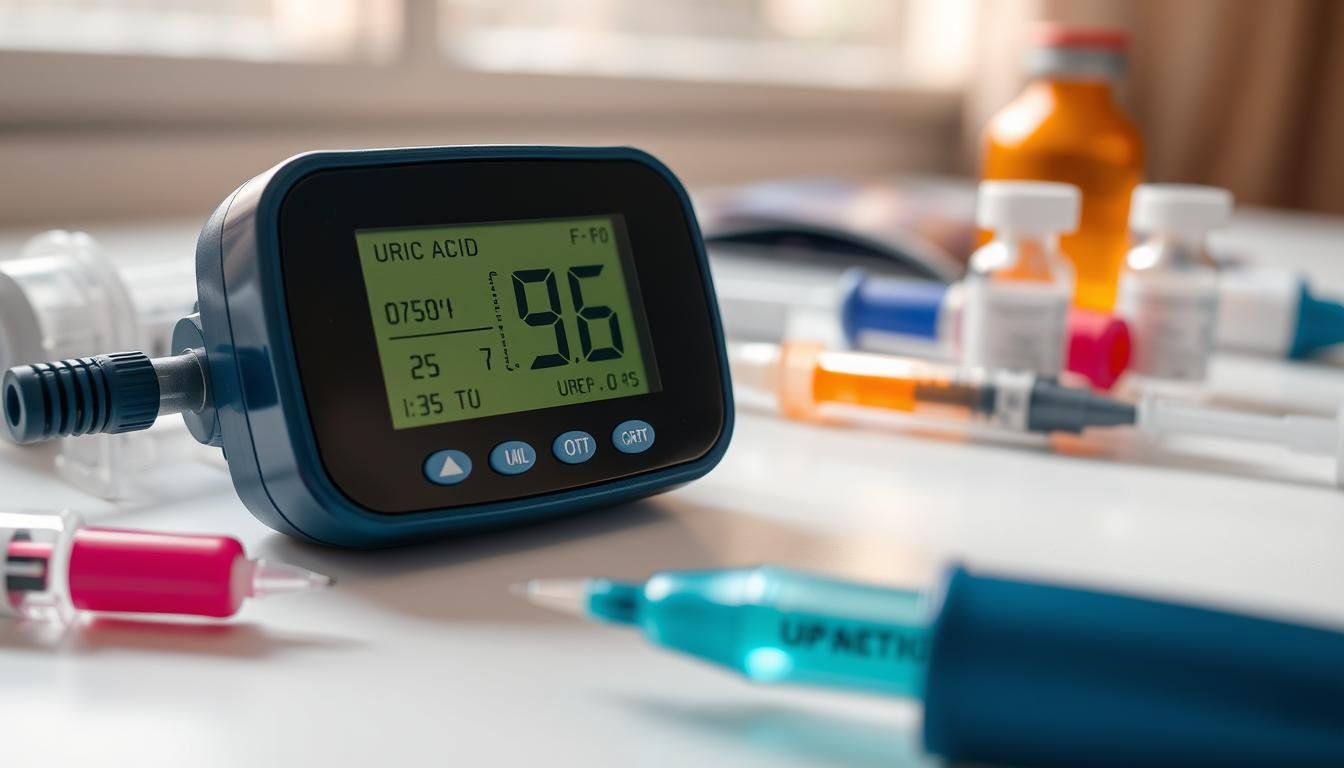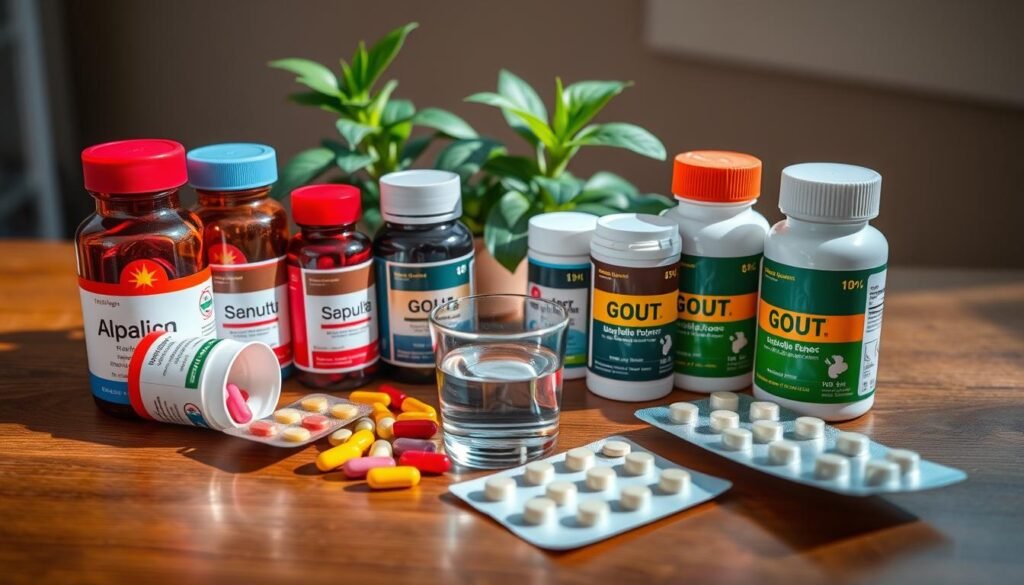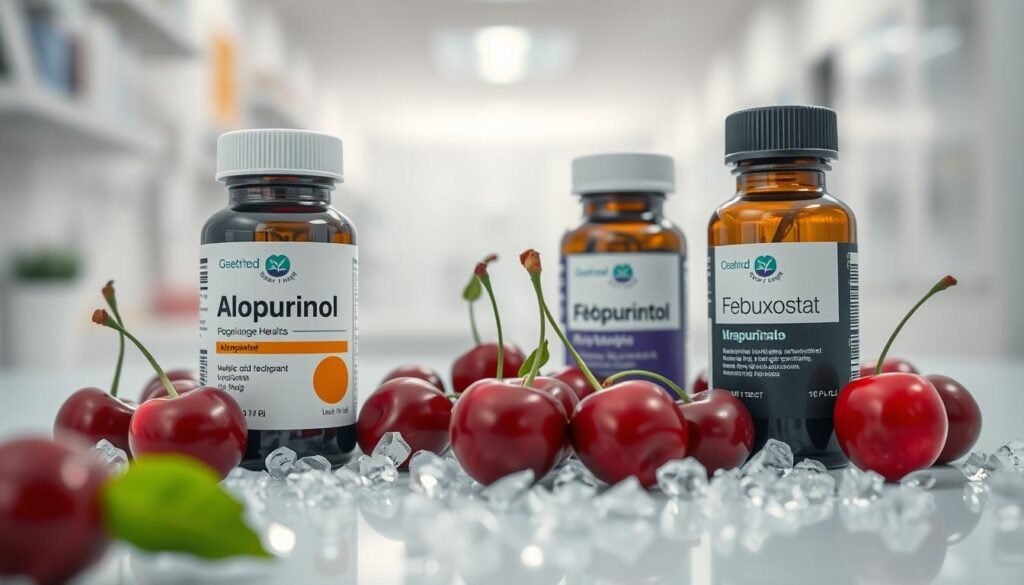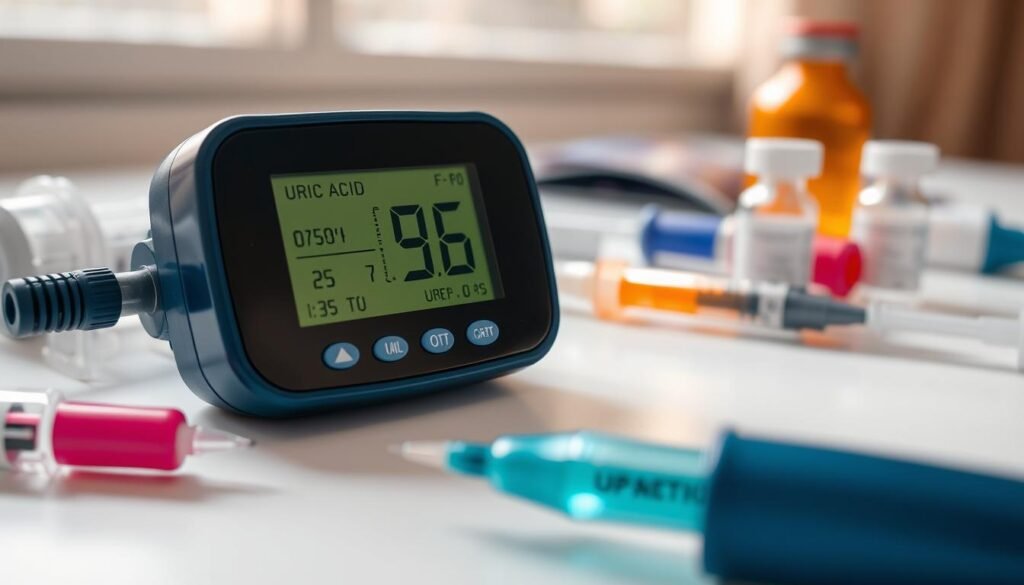Physical Address
304 North Cardinal St.
Dorchester Center, MA 02124
Physical Address
304 North Cardinal St.
Dorchester Center, MA 02124

Gout is a painful form of arthritis that affects about 9.2 million adults in the US1. It’s a big health issue, causing sudden, severe pain and swelling in joints2. Seeing how gout affects loved ones, we know how crucial it is to manage and treat it well.
The American College of Rheumatology (ACR) updated its guidelines in 2020. They offer 42 recommendations, with 16 being “strong” based on solid evidence1. These guidelines focus on using medications to control uric acid levels and prevent gout problems2.

Changing your lifestyle is also key in managing gout. Drinking less alcohol and eating fewer purine-rich foods like red meat helps2. Staying active with walking, biking, or swimming also improves joint health2.
Gout is a painful form of arthritis that affects millions of people worldwide. Studies from the Mayo Clinic and Taiwan show a big increase in gout cases, affecting both young and old3.
Gout usually hits one joint at a time, often the big toe. It causes severe pain and swelling4. Men are more likely to get gout than women, with a ratio of about 9:1. The most common age for it is between 40 to 60 years3.
The main cause of gout is uric acid crystals in the joints. This leads to inflammation and pain. High blood uric acid levels, or hyperuricemia, can cause this buildup.
About 90% of gout cases are due to not being able to get rid of enough uric acid. This is often because of genetics or certain medicines. The other 10% is due to making too much uric acid3.

Several factors can increase your chance of getting gout. These include being overweight, taking certain medicines, and having a family history of gout4. Eating foods and drinks high in purines, like alcohol and red meat, can also raise uric acid levels4.
Health conditions like heart failure and diabetes also raise the risk of gout4. Younger people are more likely to get gout due to excess weight and diet. Older people are at risk due to obesity and more use of diuretics3. Even injuries, like stubbing a toe, can trigger a gout flare-up3.
Gout is a painful form of arthritis that can strike suddenly. It causes severe joint pain, swelling, and inflammation. It most commonly affects the joint at the base of the big toe, but can also occur in other joints such as the ankle, knee, or elbow5. The pain is typically most intense within the first 4 to 12 hours of an attack5.
Men are three times more likely than women to develop gout. The condition usually manifests after age 40 in men and after menopause in women6. Gout tends to affect men between the ages of 30 and 50, while women’s uric acid levels approach those of men after menopause65.

During a gout attack, the affected joint may become red, warm, and extremely sensitive to touch. The pain can be so severe that even the weight of a light sheet can be unbearable. People with osteoarthritis in their fingers may experience their first gout attack in these joints6.
If left untreated, recurrent gout attacks can involve more joints, last longer, and become increasingly severe over time6. Repeated attacks may lead to erosion and destruction of the affected joints5. In advanced stages, deposits of urate crystals called tophi can form under the skin in areas like the fingers, hands, and feet5.
Several factors can increase the risk of developing gout, including:
Recognizing the symptoms of gout and understanding the risk factors can help individuals seek prompt treatment and prevent long-term complications. If you suspect you have gout, consult your healthcare provider for an accurate diagnosis and appropriate management plan.
Getting a correct diagnosis for gout is key to managing it well. Gout affects over 8 million Americans each year7. It leads to about 7 million doctor visits in the U.S., costing nearly $1 billion7. Doctors use tests like joint fluid analysis, blood tests, and imaging to figure out if someone has gout.

Joint fluid analysis is the most reliable test for gout8. It involves taking fluid from the joint and checking it for urate crystals under a microscope. Finding these crystals means you have gout.
Blood tests check uric acid levels. But, not everyone with gout has high uric acid in their blood9. The blood should have less than 6.0 mg/dl for gout management8. These tests also help doctors adjust treatment for gout9.
Doctors might also check kidney function with creatinine and BUN tests9. Urinalysis can show high uric acid levels, which can lead to kidney stones9. This test is used with others to diagnose gout8.
Imaging tests like X-rays, ultrasounds, and DECT help diagnose gout and rule out other joint pain causes9. X-rays can show joint damage from chronic gout8. Ultrasound uses sound waves to find urate crystals or tophi in joints8. DECT scans are useful when other tests are not clear8.
| Test | Purpose | Normal Range |
|---|---|---|
| Uric Acid Blood Test | Measures uric acid levels in blood | 3.5-7.2 mg/dl |
| Uric Acid Urine Test | Measures uric acid levels in urine | 250-750 mg |
| Synovial Fluid Test | Detects urate crystals in joint fluid | N/A |
| X-ray, Ultrasound, DECT | Visualize joint damage and urate crystals | N/A |
When a gout attack hits, having the right meds is key to ease the pain and swelling. The usual go-tos are NSAIDs, colchicine, and corticosteroids. These help lessen symptoms and shorten the attack’s length, which can last from 3 to 10 days10.

NSAIDs are a top pick for quick pain relief and swelling reduction. You can find over-the-counter ibuprofen and naproxen easily. For more severe cases, your doctor might prescribe stronger NSAIDs10. Always stick to the dosage and watch out for side effects like stomach issues and heart risks.
Colchicine is great for treating gout attacks early on. It cuts down inflammation and stops uric acid crystals from building up in joints. But, it can cause nausea, diarrhea, and stomach pain. So, it’s important to follow the dosage your doctor gives you10.
If NSAIDs or colchicine aren’t an option, corticosteroids are a good alternative. These strong anti-inflammatory drugs can be taken by mouth or injected into the joint. They offer fast relief from pain and swelling. Yet, long-term use can lead to weight gain, bone thinning, and higher infection risk11.
| Medication | Type | Benefits | Side Effects |
|---|---|---|---|
| Ibuprofen | NSAID | Quick pain relief, reduces inflammation | Stomach irritation, increased heart risk |
| Colchicine | Anti-inflammatory | Reduces inflammation, prevents uric acid crystal buildup | Nausea, diarrhea, abdominal pain |
| Prednisone | Corticosteroid | Powerful anti-inflammatory, rapid relief | Weight gain, osteoporosis, increased infection risk |
It’s vital to work with your doctor to find the best gout medication for you. They’ll consider your condition’s severity, your health, and any drug interactions.
Managing gout means treating attacks and preventing long-term damage. Urate-lowering therapy is key to avoid joint damage, tophi, and kidney stones. It aims to keep serum uric acid below 6 mg/dL, using drugs that block or remove uric acid12.
Allopurinol and febuxostat are top choices for blocking uric acid production. Allopurinol is often the first choice, starting with a low dose to reduce side effects. Febuxostat is for those who can’t take allopurinol or have kidney issues. These drugs stop the enzyme xanthine oxidase from making uric acid13.

Probenecid helps the kidneys remove uric acid better. It’s for those who make less uric acid or have normal kidneys. Probenecid stops the kidneys from reabsorbing uric acid, letting more be excreted14.
| Medication | Mechanism of Action | Dosage | Side Effects |
|---|---|---|---|
| Allopurinol | Blocks uric acid production | 100-800 mg daily | Rash, nausea, diarrhea |
| Febuxostat | Blocks uric acid production | 40-80 mg daily | Liver function abnormalities, nausea |
| Probenecid | Enhances uric acid removal | 250-500 mg twice daily | Headache, nausea, kidney stones |
Starting urate-lowering therapy requires regular checks of serum uric acid levels. Adjusting the dose is crucial. Also, starting therapy can sometimes cause gout attacks. So, using colchicine or NSAIDs as a preventive measure is often needed13.
The key to successful gout management is a combination of medication, lifestyle modifications, and regular follow-up with a healthcare provider.
By lowering uric acid levels and making lifestyle changes, gout patients can reduce attack frequency and severity. This approach helps prevent complications and improves life quality.
Making lifestyle changes is key to managing gout and preventing future attacks. By following a gout diet, staying at a healthy weight, and drinking plenty of water, people with gout can live better lives. They can also cut down on painful attacks15.
Changing what you eat is important for gout management. Eating less of foods high in purines, like red meat and some seafood, can lower uric acid levels15. Also, drinking less alcohol, especially beer and liquor, is good because it can raise uric acid levels and slow its removal16.
Eating foods low in purines is also good. The Mediterranean diet, full of fruits, veggies, whole grains, and healthy fats, is great for gout1516. Dairy like yogurt, milk, and cheese can also help lower uric acid levels and prevent gout attacks1516.
| Food Category | Recommended | Limit or Avoid |
|---|---|---|
| Meats | Lean poultry, lean pork | Red meat, organ meats, turkey, goose |
| Seafood | Fatty fish (in moderation) | Shellfish, anchovies, sardines |
| Dairy | Low-fat milk, yogurt, cheese | Full-fat dairy products |
| Fruits | Cherries, citrus fruits | Sugary fruits (in excess) |
| Alcohol | None | Beer, liquor |
Being overweight is a big risk for gout, so keeping a healthy weight is important15. Regular exercise, especially at a moderate level, can reduce inflammation and pain. It can also make gout attacks less frequent15. Low to moderate intensity exercises might be better than high-intensity ones for gout15.
“Exercise is like a double-edged sword when it comes to gout. Finding the right balance is key to reaping the benefits without triggering a flare.”
Drinking enough water is key for gout sufferers. It helps get rid of uric acid, which lowers the chance of crystals forming in joints. But, avoid sugary drinks, especially those with high-fructose corn syrup, as they can raise uric acid levels15.

By making these lifestyle changes, people with gout can manage their condition better. Working with healthcare professionals to create a personalized plan can improve health and quality of life15.
Some people with gout look into alternative gout treatments and complementary therapies to feel better. These might include changing what they eat, taking herbal supplements, or practicing mind-body techniques. But, not much research supports their effectiveness17.
Cherry juice is a popular natural remedy for gout. A 2012 study showed that eating 10 cherries a day can cut gout attacks in half18. Also, a 2009 study found that more vitamin C can lower the risk of getting gout18.

Herbal supplements like evening primrose and methylsulfonylmethane (MSM) are also used. Evening primrose contains GLA, and MSM helps reduce inflammation. The recommended dose for evening primrose is 3,000 mg, and MSM is taken at 3,000 mg twice a day18. In traditional Chinese medicine, Ermiao wan is used to treat gout with fewer side effects18.
Other complementary therapies include acupuncture for pain and homeopathic remedies like Aconite for sudden symptoms17. Always talk to a healthcare provider before trying these treatments to make sure they’re safe and won’t interact with other medicines.
“While complementary and alternative therapies may offer some relief for gout patients, they should not replace proven medical treatments. Open communication with your healthcare provider is essential when exploring these options.”
Lifestyle changes are also key in managing gout. Eating less meat and shellfish can help prevent attacks17. Drinking 6 to 8 glasses of water a day helps flush out uric acid. Drinking coffee in moderation can also help with symptoms17. Regular exercise, at least 30 minutes a day, five times a week, is also important for managing gout17.
Managing gout well needs a strong team effort between you and your healthcare provider. Together, you can create a gout treatment plan that fits your needs. Good patient-provider communication is crucial for the best results.

Your healthcare provider will help pick the right treatments for you. They consider how severe your gout is, your overall health, and any other health issues. NSAIDs and colchicine are often first choices for sudden gout attacks. Allopurinol is usually used at 300 mg/day for long-term gout19. It’s important to talk about the good and bad sides of each medicine with your provider.
When you meet with your healthcare provider, be ready to share your symptoms, lifestyle, and any worries about your gout treatment. The American College of Rheumatology has guidelines for managing gout20. Your provider will use these to create a plan that meets your needs and goals.
“The treat-to-target goal for serum UA concentrations in gout is <6 mg/dL.”21
It’s important to keep track of how well your treatment is working. Your healthcare provider will check on you regularly. They will look at your uric acid levels and adjust your treatment or advice as needed. Make sure to go to these appointments and share any changes in your symptoms or side effects.
Remember, monitoring gout is an ongoing task. As your condition changes, your treatment plan might need to change too. By keeping the lines of communication open with your healthcare provider and being active in your care, you can manage your gout well and improve your life20.
Living with gout can be tough, but there are ways to make it easier. Gout often hits the toes, ankles, and knees22. It’s key to manage stress, as it can make symptoms worse23. Getting enough rest and doing stress-reducing activities can help22.
Changing your diet is a big step in fighting gout. Avoid foods high in purines like shellfish and red meat23. Eating foods low in purines can help prevent flare-ups22. Drinking lemon water can also lower uric acid levels22.
Drinking plenty of water is crucial for managing gout. Aim for 8 to 16 cups of fluids a day, with half being water23. Water can reduce swelling and inflammation22. Drinking coffee might also lower the risk of gout flare-ups22.
When gout strikes, start treatment right away, like taking your meds22. Treating it early can make it less severe23. Use NSAIDs, colchicine, and corticosteroids to manage symptoms22. Elevate the joint and use over-the-counter pain relievers like ibuprofen to ease symptoms22. If symptoms don’t get better in 48 hours, see a doctor for more help22.
Changing your lifestyle is also key in managing gout. Regular exercise and keeping a healthy weight can help22. Applying ice to the joint can also reduce inflammation22. Cutting down on alcohol, especially beer, is also a good idea2322.
Being part of a gout support group can offer great support and advice. Sharing experiences and tips can help you cope better. Keeping in touch with your healthcare team and asking for help when needed can greatly improve your life.
| Coping Strategy | Benefits |
|---|---|
| Dietary changes | Reduces purine levels and likelihood of flare-ups |
| Staying hydrated | Flushes out uric acid and reduces inflammation |
| Prompt treatment | Reduces length and severity of flares |
| Exercise and weight management | Helps manage gout and prevent flare-ups |
| Joining a support group | Provides insights and emotional support |
Remember, you are not alone in your journey with gout. With the right coping strategies and support, you can effectively manage your condition and maintain a high quality of life.
Gout is a common form of arthritis, affecting about 1 to 2% of adults in Germany. This number goes up to 7% for those over 6524. In Australia and New Zealand, it affects around 1.7% and 2.7% of the population, respectively. It’s more common among Maori and islander populations in New Zealand25.
Managing gout well means using medicines, changing your lifestyle, and keeping an eye on your health. Working with your doctor helps you create a plan to fight off gout attacks and avoid long-term problems.
Medicines are key in treating gout attacks and stopping them from happening again. Low-dose colchicine works just as well as high-dose, with fewer side effects25. Allopurinol, a first choice for lowering uric acid, starts at 100 mg a day for people with normal kidneys25. Starting treatment with urate-lowering drugs for at least six months is important to prevent more gout attacks25.
Changing your lifestyle is also crucial. This includes keeping a healthy weight, exercising, and eating right for gout. It’s also important to have blood tests every year to check how gout is doing and if treatment is working24.
Using imaging like sonography and dual-energy CT (DECT) helps spot gout in soft tissues and joints. This helps doctors diagnose and track how well treatment is working24.
Knowing about the latest treatments and following guidelines helps manage gout well. With the right mix of medicines, lifestyle changes, and regular check-ups, people with gout can live better lives. They can do more and feel better every day.
Gout happens when uric acid crystals build up in the joints. This causes pain and swelling. High uric acid levels can come from genes or lifestyle, like eating too much meat or drinking a lot of alcohol.
Gout symptoms include sudden, severe pain and swelling in the joints. It often hits the big toe but can also affect other joints. Over time, nodules called tophi may form from uric acid crystals.
Doctors look at symptoms and the joint’s appearance to diagnose gout. They might take a joint fluid sample to find urate crystals. Blood tests check uric acid levels, but they can be tricky. X-rays and other scans help see the crystals and rule out other problems.
To treat gout attacks, doctors use NSAIDs, colchicine, and corticosteroids. NSAIDs, like ibuprofen, help with pain and swelling. Colchicine works well but can cause stomach issues. Corticosteroids can be taken by mouth or injected into the joint.
Urate-lowering therapy is for those with frequent gout attacks or tophi. It includes drugs like allopurinol and febuxostat to lower uric acid levels. The American College of Rheumatology recommends starting with a low dose of allopurinol to avoid side effects.
To manage gout, change your diet and lifestyle. Avoid foods high in purines and alcohol. Stay active and eat well to keep a healthy weight. Drinking plenty of water and avoiding sugary drinks is also key.
Some people try herbal supplements or acupuncture for gout. But, there’s not much proof they work. Always talk to your doctor before trying new treatments to make sure they’re safe and won’t interact with your meds.
Working with your doctor is key to managing gout. Talk about treatment options and set goals together. Share any concerns or side effects. Your doctor may adjust your treatment to keep uric acid levels in check.